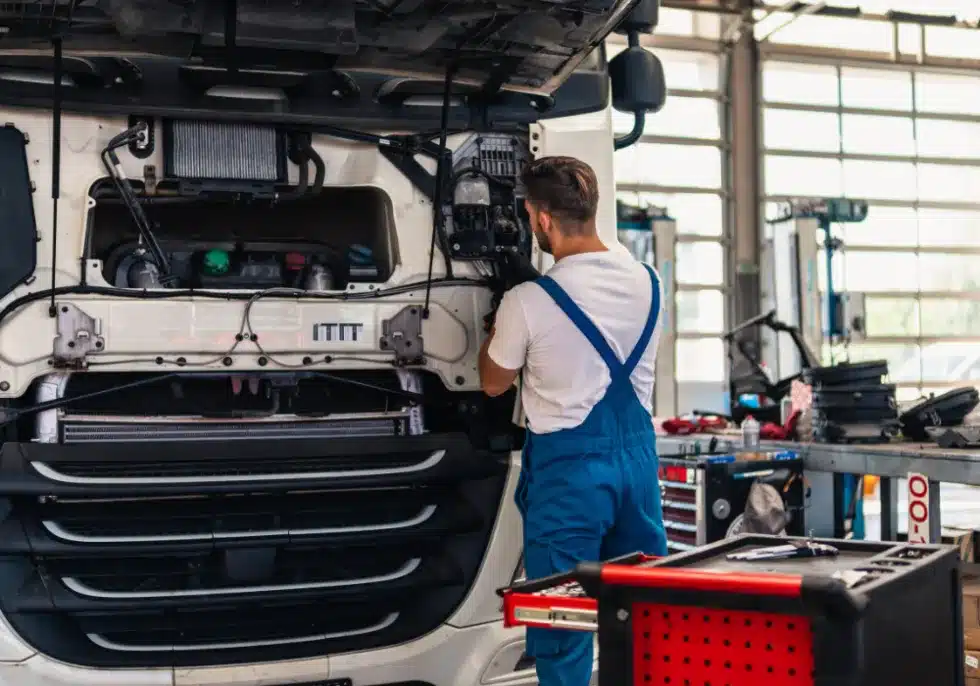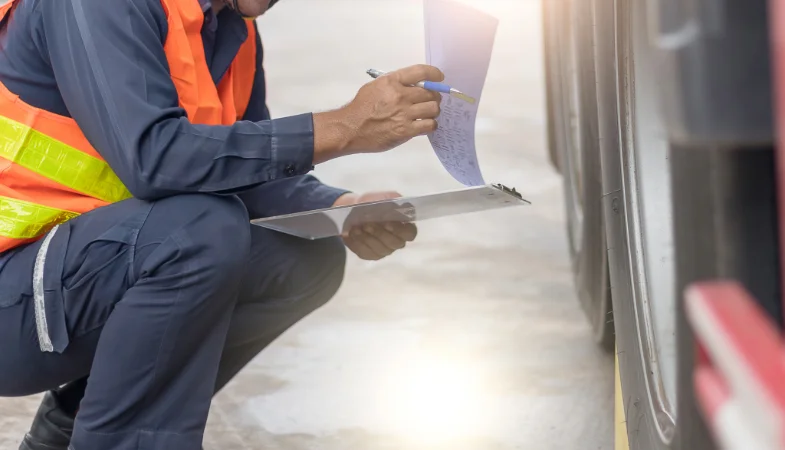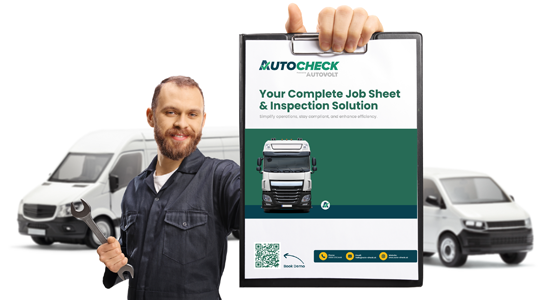Why Daily Vehicle Inspections Matter
Daily vehicle inspections play a vital role in fleet management and road safety. By catching issues early—such as worn tires, faulty lights, or brake problems—these checks help prevent minor defects from turning into dangerous and costly breakdowns. For fleet operators, that means fewer unexpected repairs, less downtime, and a reduced risk of roadside incidents.
Most importantly, regular inspections contribute to the safety of both drivers and other road users. With the demands of long hours and tight schedules, even experienced drivers can miss subtle signs of trouble. A systematic daily check keeps everyone alert to potential problems, ensuring vehicles remain roadworthy and compliant with UK regulations, including those set out by the DVSA.
Staying proactive with daily inspections supports both operational efficiency and legal compliance, making it a key responsibility in any fleet maintenance programme.
This blog post outlines the key areas that should be covered during these inspections, drawing from the guidance provided by the Driver and Vehicle Standards Agency (DVSA).
Daily External Fleet Vehicle Inspection Checklist
Before hitting the road each day, it’s essential to carry out a thorough walkaround check to catch any issues that could cause safety concerns or lead to costly downtime. Here’s what your daily external inspection should include:
• Examine the condition of the vehicle’s bodywork, checking for any visible damage, dents, or corrosion.
• Ensure windows, mirrors, lights, and the number plate are clean and unobstructed for maximum visibility.
• Inspect the windscreen and wiper blades for chips, cracks, or excessive wear.
• Check tyres for cuts, bulges, uneven wear, and verify they’re inflated to the correct pressure.
• Confirm the security of the load, trailer, or any items stored on a roof rack—nothing should be loose or at risk of shifting.
• Verify the presence of essential spares, such as a roadworthy spare wheel and a functional jack.
Making these checks a daily habit helps maintain compliance and keeps your fleet running safely and efficiently.
6–8 Weekly Vehicle Inspection (incorporating DVSA recommendations)
Internal Cabin Checks
Before operating any fleet vehicle, it’s essential to conduct a thorough inspection inside the cab. These checks help ensure your comfort, safety, and compliance with legal requirements—especially important if you share your vehicle with other drivers, or if the vehicle has been recently maintained.
Key areas to review inside the cab include:
• Seat and mirror adjustments: Ensure the seat, headrest, and all mirrors are correctly positioned for clear visibility and comfort. You may need to readjust if another driver used the vehicle previously.
• Seat belt: Inspect for wear or damage and confirm proper function. Fasten and release to check the locking mechanism.
• Dashboard warning lights: Before starting your journey, turn the ignition and verify that all dashboard warning lights illuminate, then extinguish as expected. Watch for any persistent alerts indicating underlying issues.
• Controls and visibility features: Test the operation of indicators, headlights, brake lights, horn, and windscreen wipers/washers to guarantee they’re working as intended.
• Brakes and fuel: Confirm the parking brake engages and releases smoothly. Ensure there’s enough fuel for your planned route, and check for any unusual brake feel or noise.
Completing these checks not only keeps you safe and legal but also helps prevent avoidable breakdowns or delays down the road.
Engine Compartment
• Belts and hoses
• Battery and connections
• Air and fuel filters
• Exhaust system
Undercarriage
• Suspension components
• Steering linkages
• Brake components (drums, discs, callipers)
• Exhaust system
Brakes
• Brake performance test (road test or using a brake tester)
Steering
• Steering play and response
Tyres
• Thorough inspection of all tyres, including sidewalls
Lights and Signals
• Function test of all lights and signals
Bodywork
• Check for any damage or signs of wear and tear
Load Security
• If applicable, check load securing equipment
Cleanliness for Effective Inspections
Keeping vehicles clean and tidy isn’t just about appearances—it plays a key role in facilitating thorough inspections and ongoing maintenance. Dirt and grime can hide developing faults such as fluid leaks, cracks, or wear on key components, making issues harder to spot before they become serious problems. A clean vehicle allows for easier identification of new damage, corrosion, or general wear and tear that could impact safety or compliance.
Additionally, regular cleaning helps ensure that critical inspection points—such as lights, reflectors, undercarriage components, and braking systems—are easily accessible and visible. In the long run, maintaining a tidy vehicle not only supports efficient inspections but also contributes to prolonging the lifespan of your fleet and upholding DVSA standards.
Equipment Storage and Organisation
Proper storage of equipment is an often-overlooked aspect of keeping fleet vehicles road-ready. Ensuring all tools and loose items are securely stowed reduces the risk of injury during transit and makes daily checks quicker and more effective.
• Use designated storage compartments or toolboxes to prevent loose equipment from moving around the cab or trailer.
• Routinely tidy the cab area and remove unnecessary clutter, so it’s easier to spot new hazards or faults.
• Secure all load-securing devices and emergency kits after use.
• Regularly check that straps, nets, and brackets are properly fastened and free from damage.
Taking time to organise and secure equipment not only promotes driver safety but also helps staff identify maintenance issues before they become a problem.
Essential Equipment to Carry
In addition to conducting thorough inspections, it’s important to ensure each fleet vehicle is equipped with key items to support safety and compliance. The following should always be present:
• Vehicle manual for reference while on the road
• A compliant fire extinguisher suitable for vehicle use
• Fully stocked first aid kit
• Reliable torch or flashlight for low-light situations
• Warning triangle (such as the AA or Halfords models) to provide advance notice in case of roadside emergencies
Having these essentials on board not only helps drivers respond effectively to unexpected situations but also supports best practice in line with UK regulations.
Trailer-Specific Checks (aligned with DVSA best practices)
Coupling and Uncoupling Mechanisms
• Check for proper operation and security
Brakes
• Check brake operation and adjusters
Suspension
• Inspect for any damage or signs of wear and tear
Tyres and Wheels
• Check tyre pressures, tread depth, and condition
Lights and Signals
• Check function of all lights and signals
Record Keeping
Maintain accurate and up-to-date records of all inspections. These records should include:
• Date and time of inspection
• Name of the person conducting the inspection
• Vehicle registration number
• Details of any defects found
• Actions taken to rectify defects
The image below showcases a portion of a completed 6–8 weekly HGV inspection carried out on Autocheck.
Simplifying Inspections with Autocheck
Autocheck is a user-friendly, cloud-based workshop and inspection system designed to streamline your vehicle maintenance processes. With a fixed monthly fee, you can:
• Easily add an unlimited number of vehicles and users.
• Create and customise digital inspection sheets specifically for 6–8 weekly checks, ensuring consistency and compliance with DVSA guidelines.
• Conduct inspections on any device.
• Capture images and videos of defects directly within the system.
• Generate automated reports and notifications.
• Track maintenance history and service schedules.
• Improve communication and collaboration between drivers, mechanics, and management.
By utilising Autocheck, you can significantly improve the efficiency and accuracy of your 6–8 weekly inspections. Our system helps you:
• Reduce paperwork and administrative burden.
• Minimise the risk of missed inspections or overlooked defects.
• Improve vehicle uptime and reduce downtime.
• Demonstrate compliance with DVSA requirements.
Important Notes
Defects
Any defects found during the inspection must be rectified promptly.
Professional Inspections
For more thorough inspections, consider engaging a qualified mechanic or vehicle inspector.
Legal Compliance
Adhering to these inspection requirements is crucial for legal compliance and to avoid fines and penalties.
By conducting regular and thorough inspections, and leveraging the power of Autocheck, you can help to ensure the safety and reliability of your HGVs, PSVs, and trailers, while also minimising the risk of breakdowns and costly repairs.
Contact us today for a free demo and see how Autocheck can transform your business.
By conducting thorough, regular inspections and using a purpose-built system like Autocheck, fleet operators can ensure their vehicles are always safe, compliant, and ready for the road.
Contact us today for a free demo and discover how Autocheck can transform your inspection process.






